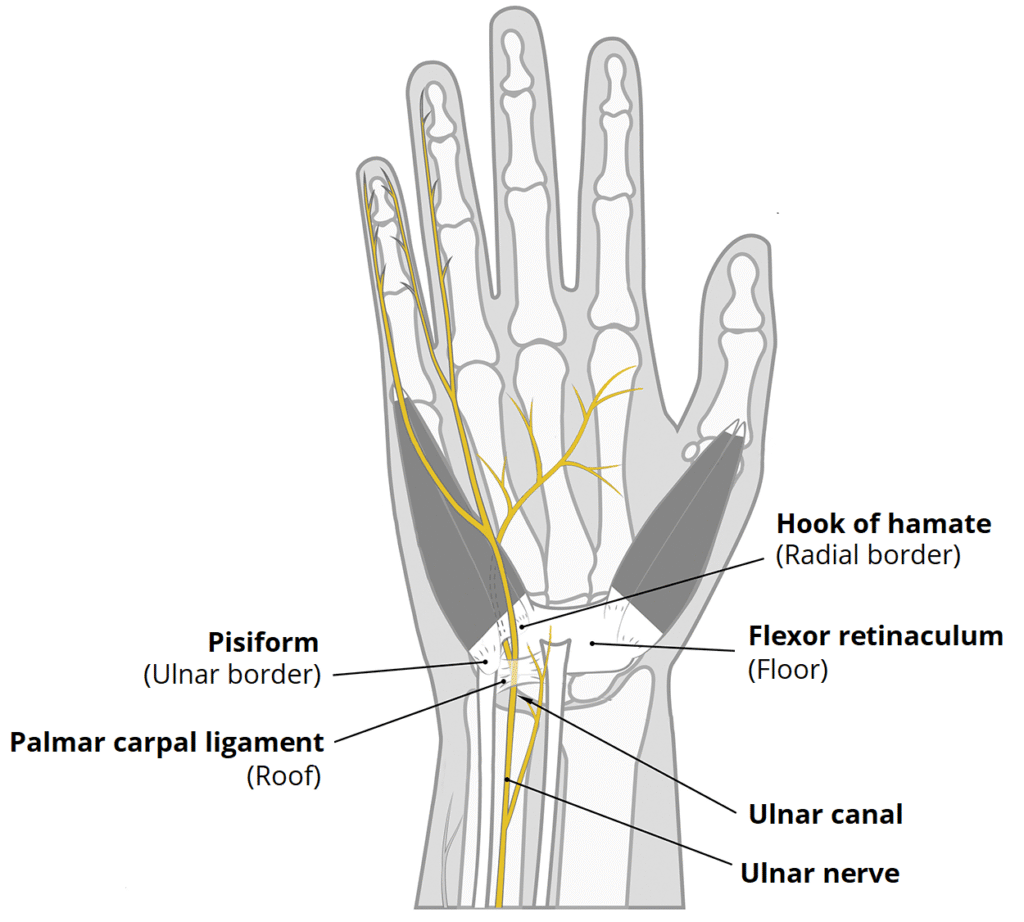Guyon’s canal release, also known as an ulnar nerve release at the wrist, is a surgery that aims to restore nerve function, alleviate symptoms, and prevent further damage to the Guyon’s canal in the wrist.
Indications for surgery
Conservative measures are often attempted first, but when these fail to provide relief, surgery becomes a viable option to restore hand functionality. Surgery may be a recommended avenue if you are experiencing:
- Persistent symptoms of ulnar tunnel syndrome, such as numbness, tingling, or weakness in the ring and little fingers that do not respond to conservative treatments like splinting or medication
- Severe compression causing hand muscle atrophy or significant loss of function
- Nerve compression caused by conditions like arthritis, ganglion cysts, repetitive wrist movements, or trauma to the wrist
What the surgery involves
The goal is to alleviate pressure on the ulnar nerve, allowing it to heal and restore normal hand function. Guyon’s canal release is performed under local, regional, or occasionally general anaesthesia (WALANT surgery).
The procedure steps include:
- An incision over Guyon’s canal to access the ulnar nerve
- The transverse carpal ligament, which forms the roof of the canal, is carefully released to create more space for the nerve
- Any additional compressive structures, such as scar tissue or cysts, are meticulously removed
- The incision is closed with sutures, and a protective dressing is applied

What to expect after surgery
Post-surgery, you may notice a gradual improvement in symptoms, although full recovery can take time. A small dressing will protect the surgical site, and you can typically resume light hand use immediately. However, gripping or strenuous activity should be avoided until cleared by a doctor.
Pain, tingling, and numbness often improve gradually over weeks to months, depending on the severity of the nerve compression. Pain and tingling improve first, and weakness takes longer to recover. In severe cases where the nerve was compressed for a long time symptoms will improve but may not completely return to normal, in particular weakness. Rehabilitation exercises are recommended to strengthen the wrist, improve flexibility, and promote nerve healing.
How long will you be in the hospital?
Guyon’s canal release is performed as a day procedure. Most patients can return home a few hours after surgery but should arrange for someone to assist for the first 24 hours if anaesthesia is used. Dr Lambers usually performs this under local anaesthetic meaning your wrist is numb but you remain awake. [Read more about this here].
Usual recovery time
- You may resume light activities within a few days, while more strenuous tasks might require 4–6 weeks or longer
- Driving is typically possible within 1–2 weeks once hand strength and mobility are sufficient and the wound has healed
Potential risks
While the procedure is proven and generally safe, potential risks include:
- Persistent symptoms or recurrence of nerve compression
- Infection at the incision site
- Injury to the ulnar nerve
- Scarring or tenderness around the surgical site
Taking your time to decide
The choice to undergo Guyon’s canal release surgery is a personal one and should not be rushed. Take the time to explore all treatment options, ask Dr Lambers questions, and consider what’s best for your lifestyle and goals. A thorough discussion with Dr Lambers can help you make an informed decision about whether this procedure is right for you.

